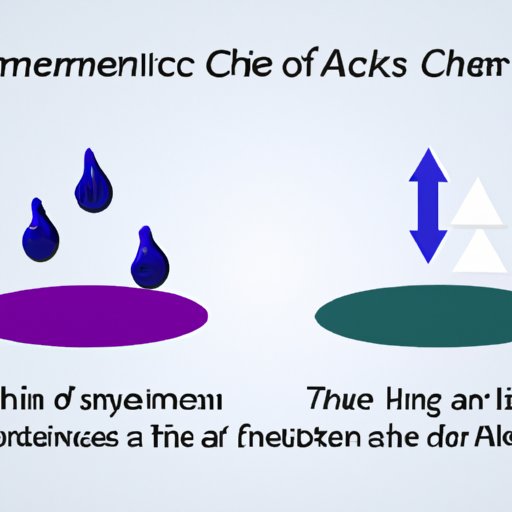
Introduction
Understanding the difference between physical and chemical changes is crucial for anyone who wants to understand matter and its properties. Even though these two types of changes may seem similar, they have different characteristics that distinguish them from each other. Knowing the difference can help you identify changes in matter and understand how it behaves.
Understanding The Basics: Physical vs. Chemical Changes
Physical changes are changes in the form or appearance of matter that do not change the chemical composition of the substance. Examples include changes in size, shape, and state (solid, liquid, or gas). Chemical changes, on the other hand, alter the chemical composition of matter. New substances are formed with different properties and characteristics than the original substance.
One way to distinguish between physical and chemical changes is to ask whether the change alters the identity of the substance. If the same substance remains after the change, it is a physical change. If a new substance is created, it is a chemical change.

From Altering Forms to Altering Substances: The Differences Between Physical and Chemical Changes
When it comes to changes in substances, they can be divided into two types of changes: physical and chemical. Physical changes alter a substance’s physical appearance, but not its chemical composition. They are typically reversible changes as they do not involve the breaking or forming of chemical bonds. Examples of physical changes include changes of state, boiling, melting, evaporation, dissolving, and changes in shape or size.
Chemical changes, on the other hand, involve the breaking and forming of chemical bonds in a substance, resulting in a new substance with different physical and chemical properties than the original substance. Examples of chemical changes include burning, rusting, and digestion. Chemical changes are irreversible. Once a substance undergoes a chemical change, it cannot be changed back to its original form.
Breaking It Down: The Properties and Characteristics of Physical and Chemical Changes
Physical changes do not affect the chemical composition of a substance. As a result, they typically do not involve changes in energy or mass. Physical changes only affect the external appearance of the substance, such as changes in size, shape, texture, or state. Physical changes do not produce new substances and are usually reversible.
Chemical changes, on the other hand, involve the breaking and forming of chemical bonds, which results in the production of new substances. This process involves a change in energy and mass as well. During a chemical change, energy is either released or absorbed, and mass is conserved. Chemical changes are irreversible, and once a substance undergoes a chemical change, its chemical and physical properties will be different from the original substance.
The Science Behind It: Comparing Physical and Chemical Changes in Matter
All matter is made up of atoms and molecules that interact with each other. The properties of matter depend on the types of atoms and molecules that make it up, and the way that those atoms and molecules interact. This interaction leads to the emergence of physical and chemical properties of matter.
Physical properties of matter include properties such as color, density, boiling point, melting point, and electrical conductivity. Chemical properties of matter include properties such as reactivity, flammability, toxicity, acidity, and basicity.
Transformations in Matter: Identifying Physical and Chemical Changes
Identifying physical and chemical changes in matter can be challenging, but there are some clues to look for. Here are some tips for identifying physical changes:
- Changes in size or shape
- Changes in state (solid, liquid, gas)
- Changes in texture or appearance
- Changes in temperature or pressure
Here are some tips for identifying chemical changes:
- Production of gas
- Production of a precipitate (an insoluble solid in a liquid)
- Change in color
- Change in temperature or light given off
Examining Change: A Comprehensive Guide to Physical and Chemical Changes
To examine physical and chemical changes in matter, follow these steps:
- Observe the substance before and after the change.
- Identify any changes in the substance’s physical or chemical properties.
- Determine if the change altered the substance’s identity.
- If it did not alter the identity of the substance, it is a physical change. If it did alter the identity of the substance, it is a chemical change.
Common mistakes when identifying changes include thinking that changes in temperature or pressure are always chemical changes. This is not always true, and you need to look for other clues to determine if the change is indeed chemical or physical.
Physical or Chemical? How to Differentiate Between the Two Types of Changes
To differentiate between physical and chemical changes, remember the key differences:
- Physical changes only alter a substance’s physical appearance, while chemical changes alter the chemical composition of the substance.
- Physical changes are typically reversible, while chemical changes are usually irreversible.
- Physical changes do not involve changes in energy or mass, while chemical changes do.
Practicing identification is a great way to get better at recognizing physical and chemical changes. Examples of changes can easily be found in everyday life, and observing these changes can help you refine your skills.
Conclusion
Understanding the differences between physical and chemical changes is important for anyone interested in the properties and behavior of matter. Physical changes are alterations in form or appearance that do not change a substance’s identity. Chemical changes alter the chemical composition of the substance and result in the formation of new substances. By following the steps outlined in this article, you can identify and differentiate between the two types of changes with ease.





